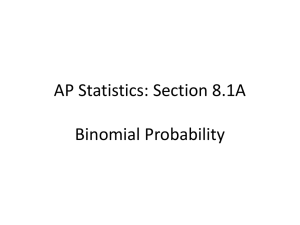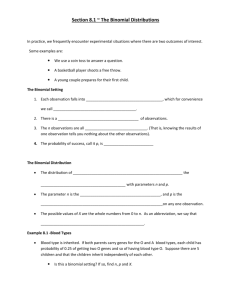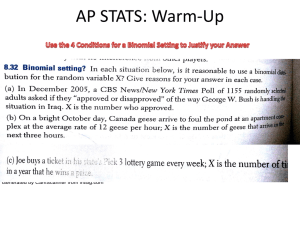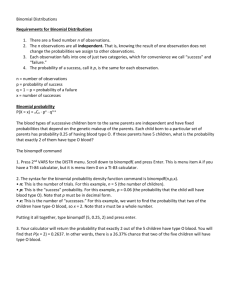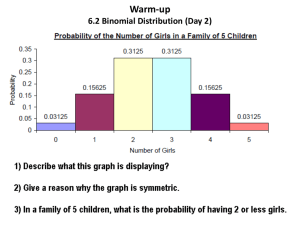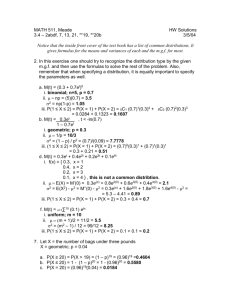Sec. 8.1 Part 1 Blank Notes
advertisement
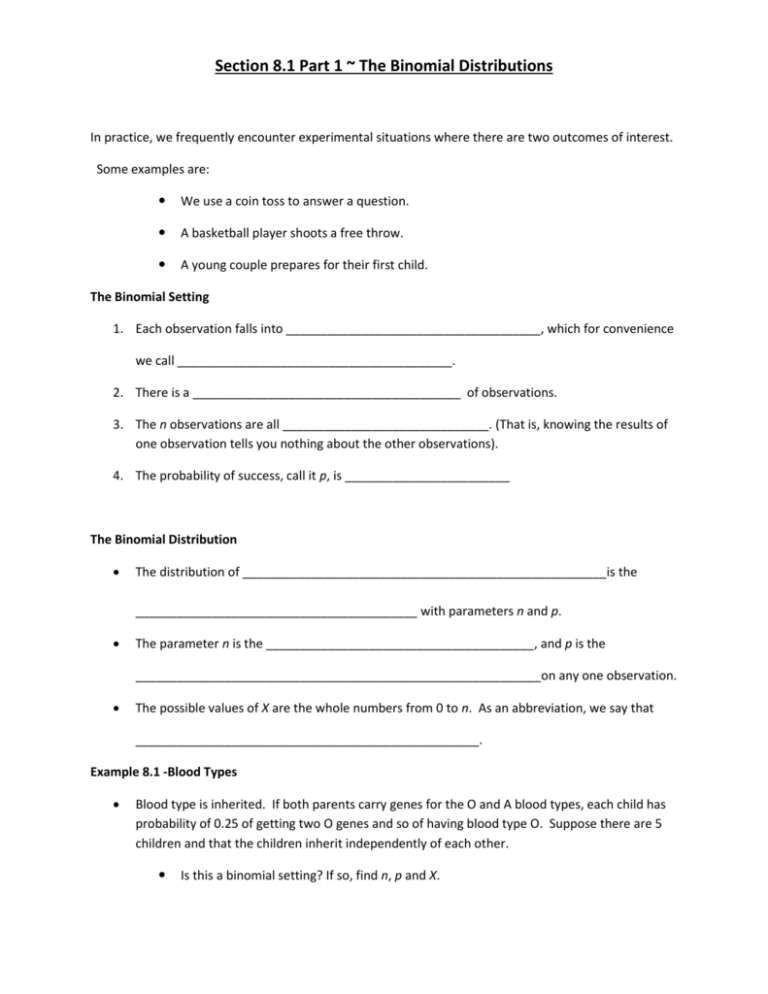
Section 8.1 Part 1 ~ The Binomial Distributions In practice, we frequently encounter experimental situations where there are two outcomes of interest. Some examples are: We use a coin toss to answer a question. A basketball player shoots a free throw. A young couple prepares for their first child. The Binomial Setting 1. Each observation falls into _____________________________________, which for convenience we call ________________________________________. 2. There is a _______________________________________ of observations. 3. The n observations are all ______________________________. (That is, knowing the results of one observation tells you nothing about the other observations). 4. The probability of success, call it p, is ________________________ The Binomial Distribution The distribution of _____________________________________________________is the _________________________________________ with parameters n and p. The parameter n is the _______________________________________, and p is the ___________________________________________________________on any one observation. The possible values of X are the whole numbers from 0 to n. As an abbreviation, we say that __________________________________________________. Example 8.1 -Blood Types Blood type is inherited. If both parents carry genes for the O and A blood types, each child has probability of 0.25 of getting two O genes and so of having blood type O. Suppose there are 5 children and that the children inherit independently of each other. Is this a binomial setting? If so, find n, p and X. n = 5, p = .25, X = B(5, .25) Example 8.2 – Dealing Cards Deal 10 cards from a shuffled deck and count the number X of red cards. There are 10 observations and each are either a red or a black card. Is this a binomial distribution? No because each card chosen after the first is dependent on the previous pick If so what are the variables n, p and X? None Example 8.3 – Inspecting Switches An engineer chooses an SRS of 10 switches from a shipment of 10,000 switches Suppose that (unknown to the engineer) 10% of the switches in the shipment are bad. The engineer counts the number X of bad switches in the sample. Is this a binomial situation? Justify your answer. While each switch removed will change the proportion, it has very little effect since the shipment is so large. In this case the distribution of X is very close to the binomial distribution B(10, .1) The sampling distribution of a count variable is only well-described by the binomial distribution is cases where the population size is _____________________________ than the sample size. As a general rule, the binomial distribution should not be applied to observations from a simple random sample (SRS) unless the __________________________________________________ (or otherwise thought of as the sample size being no more than 10% of the population) 𝑁 ≥ 10𝑛 or 𝑛 ≤ 1 𝑁 10 Example 8.5 – Inspecting Switches An engineer chooses an SRS of 10 switches from a shipment of 10,000 switches. Suppose that (unknown to the engineer) 10% of the switches in the shipment are bad. What is the probability that no more than 1 of the 10 switches in the sample fail inspection? See explanation/diagram on p.442 pdf ~ “Probability Distribution Function” Given a discrete random variable X, the probability distribution function assigns a probability to _____________________________________. The probability must satisfy the rules for probabilities given in Chapter 6. The TI-83 command _____________________________________ will perform the calculations. This is found under 2nd/DISTR/0 Example 8.6 – Corinne’s Free Throws Corinne is a basketball player who makes 75% of her free throws over the course of a season. In a key game, Corinne shoots 12 free throws and makes only 7 of them. The fans think that she failed because she is nervous. Is it unusual for Corinne to perform this poorly? Assume that the free throws are independent of each other. The number X of baskets in 12 attempts has the B(12, .75) distribution. We want the probability of making a basket on at most 7 free throws: 𝑃(𝑋 ≤ 7) = 𝑃(𝑋 = 0) + 𝑃(𝑋 = 1) + ⋯ 𝑃(𝑋 = 7) 𝑃(𝑋 ≤ 7) = .157Corinne will make at most 7 of her 12 free throws about 16% of the time. Example 8.7 – Three Girls Determine the probability that all 3 children in a family are girls. Takes on the B(3, .5) distribution 𝑃(𝑋 = 3) = binomPdf(3, . 5, 3) = .125 Cdf ~ “Cumulative Distribution Function” The cumulative binomial probability is useful in a situation of a __________________________. Given a random variable X, the cumulative distribution function (cdf) of X calculates the ______________________________________________________________________________ That is, it calculates the probability of obtaining _________________________in n trials. binomPdf vs binomCdf See example 8.8 on p.444 to see how binomPdf and binomCdf distributions compare binomCdf is also useful for calculating the probability that it takes _________________ a certain number of trials to see the first success. The calculation uses the complement rule: 𝑃(𝑋 > 𝑛) = 1 − 𝑃(𝑋 ≤ 𝑛) n = 2, 3, 4, … Using Pdf & Cdf to Find Probabilities Use the B(12, .75) distribution, find the following probabilities: 𝑃(𝑋 = 4) 𝑃(𝑋 ≤ 4) cdf(3) 𝑃(𝑋 > 4) cdf(4) 𝑃(𝑋 < 4) pdf(4) 1-cdf(4) 𝑃(𝑋 ≥ 4) 1-cdf(3)
